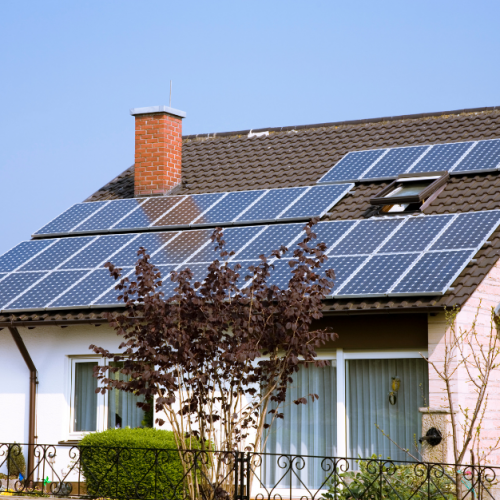

Solar panels are made out of photovoltaic cells that convert the sun’s energy into electricity.
Photovoltaic cells are sandwiched between layers of semi-conducting materials such as silicon. Each layer has different electronic properties that energise when hit by photons from sunlight, creating an electric field. This is known as the photoelectric effect – and this creates the current needed to produce electricity.
Solar panels generate a direct current of electricity. This is then passed through an inverter to convert it into an alternating current, which can be fed into the National Grid or used by the home or business that the solar panels are attached to.
Space is a key consideration. The average system size will typically take up around 20m2 roof area.
An unshaded, South facing roof is ideal for maximum electrical output. East or West facing roofs could still be considered, but North facing roofs are not recommended. A system facing East or West will yield around 15-20% less energy than one facing directly South.
Any nearby buildings, trees or chimneys could shade your roof and have a negative impact on the performance of your system.
Finding an unshaded spot is best, however sometimes shading is unavoidable.


Solar PV System is able to generate, store and power your home or business of 100% renewable energy from the sun. The Photovoltaic Cells or Solar PV Panels collect packets of the sun’s energy from sunlight, and convert it into Direct Current (DC). This current through your inverter is then changed into Alternating Current (AC) to be used domestically or commercially.
Complete Solar PV System consists of 7 Key Components.
As well as being paid for the energy generated by your solar panels, you can also reduce your energy bills by up to 50%. Electricity rates are only expected to continue growing, and a renewable energy source means that you will be able to avoid an annual energy price rise of around 10% a year.
Solar panels are strong and durable, and our solar panels come with a twenty-five year performance guarantee. So long as they receive regular checks and maintenance, however,they can last more than thirty years
Solar panels don’t have any moving parts and are largely maintenance-free. Over time though, weathering and other environmental factors such as dead leaves and traffic pollution could begin to affect your solar panels so it’s a good idea to have your solar panels checked every few years, just to ensure that they are working as efficiently as possible.
This used to be the case, but thanks to the new range of affordable solar battery storage systems, you will be able to store up energy during daylight hours for use through the night. Our clever lithium ion batteries allow you to maximise your energy generation, and use it outside of daylight hours. A home battery will mean that you don’t need to rely on energy from the grid when the sun is no longer shining.
Many customers wouldn’t know this but there are two types of Solar Panels. Solar PV and Solar Thermal.
Both utilise the sun’s energy to produce renewable energy, however through different technologies. Solar Photovoltaic or Solar PV panels, turns direct sunlight into electricity, whereas Solar Thermal panels, turns direct sunlight into heat, to provide hot water. In the great debate between choosing Solar Panels or Solar Thermal.
Solar PV Panels are currently leading. This is because unlike Solar Thermal Panels, Solar PV can be used to generate green electricity as well as heating your water. This is done through installing an immersion diverter/immersion optimiser, such as the Eddi or iBoost . These Smart devices are able to detect any excess solar generation, and instead of sending it back to the grid, divert it to heating your water tank. This is a great Solar PV system upgrade, which allows your to maximise your Solar energy usage!
The storage capacity your home will require, is dependant on your current electricity usage.
Power usage is measured in kilowatt-hours. Your monthly energy bill will indicate how many kilowatt hours you spend on a monthly basis. To calculate the battery storage you require, Deege Solar will take this value and from there will be able to calculate your energy needs.
To book a free Solar consultation, and to find out exactly what size battery your home
requires, simply contact us.
Yes! Solar photovoltaic (PV) panels generate electricity that can be used not only power your home appliances but electric vehicles too. Solar compatible EV Chargers such as the myenergi Zappi , are able to divert your excess solar energy from your Solar PV Panels directly to your plugged in EV. It’s simply, drive off sunshine! If you plan on using off-peak times to charge you car, you’ll need a solar battery to store the solar energy you’ve generated throughout the day.
After we’ve assessed your eligibility for funding, your property will have a retrofit assessment survey and a retrofit coordinator will design a plan for your home. We’re not able to give advice on energy efficiency measures for your home until that assessment has taken place.